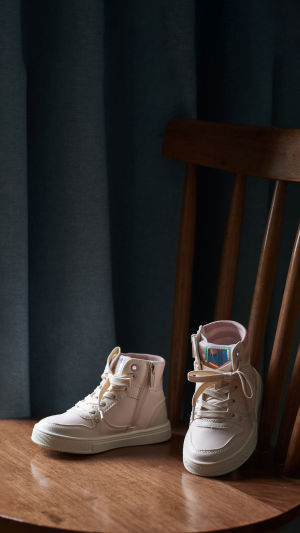With the advent of the era of fitness and sports for all, everyone from the elderly to the youngest children is enthusiastically involved in sports and exercise.
Of course, don't forget to pack a pair of sports shoes to protect your feet when you exercise, especially for children.
So how do you choose the right sports shoes for children?
Apart from being non-slip and breathable, a quality pair of children's sports shoes need to be lightweight and have a good feel for the feet, in addition to being designed and manufactured to suit the child's sporting or outdoor activities.
At the same time, the insole should preferably have arch support, a stiffened heel, and a foot space in the front.
So that children can wear them during sports to effectively relieve foot fatigue and enjoy a more comfortable sports experience.
For children's sports shoes material in the shoe material, the upper as far as possible to choose mesh, microfiber, and other materials, while keeping the shoes dry, and comfortable, avoid wearing non-breathable synthetic leather, or plastic materials made of shoes.
Choose rubber soles for wear resistance and slip resistance, and rough patterns on the soles to help increase friction and slip resistance.
Children's shoes avoid choosing too hard soles, which will affect the development of children's feet, but also can not be too soft, too soft soles wear resistance, and support performance is not up to the requirements, affecting the wearing.
The health of children's feet is the most vulnerable to disease, and many parents are not aware of the development of children's feet at different ages.
The arch of the foot is an arch-shaped structure consisting of two longitudinal arches and two transverse arches, formed when the tarsus and metatarsus are connected by ligaments, joints, muscles, tendons, and other flexible and contractile tissues.
Like the lumbar and cervical vertebrae, the arch of the foot is not inherited but is formed gradually over the course of growth and development.
Choosing the right shoes and insoles can help to promote skeletal development in the foot.
We can determine the type of arch and recommend the right shoes or insoles for children to prevent monitoring of abnormal gait and arch development.
Infants and young children aged 0-3 years: At this stage, the feet are round and smooth, and elastic, 70% of the foot bones are cartilage and there is no arch pattern.
This is a flat foot, but most flat feet at this stage are physiological and do not require medical attention.
3-6 years: This is a critical period for the growth of the child's foot and the formation of the arch.
The child's standing posture, walking habits, and even the shoes worn may affect the formation of the arch and require special attention.
6-12 years old: Children's foot bones are maturing and the arch shape is slowly moving from the developmental stage to the stable stage, with more palmar lines and good stability.
Age 13+: The foot is fully developed and the arch is formed, but trauma and lesions caused by strenuous sports activities need to be avoided at this stage.
Children's sports shoe selection myths:
Avoid choosing shoes with irritating odors. Some manufacturers use poor materials or adhesives to save costs, which can have a negative impact on children's health, so avoid choosing them.
2. Choose fewer sports shoes with mixed styles and many accessories.
When buying sports shoes, mothers and fathers should feel the children's shoes to see if the small accessories on the shoes and inside the shoes are firmly installed and resistant to pilling.
Check if there are any nail tips or broken needles exposed in the shoe and if the shoe is sharp enough to hurt your child's feet, to prevent these problems from hurting your child's feet.
Do not buy "adult-sized" children's shoes.
Generally, adult-oriented shoes such as snow boots and high heels should not be worn by children.





